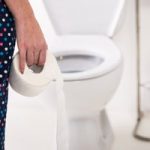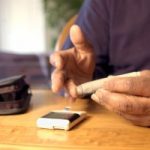
Here we explain the causes, symptoms and treatment methods for an underactive bladder in order to raise your awareness of this alternative bladder condition.
What is an underactive bladder?

An underactive bladder can encompass a variety of lower urinary tract symptoms and can often be referred to as a weak bladder. The focus on an underactive bladder has increased in recent years, especially among the aging population and those who are obese.
What causes an underactive bladder?

Central nervous system disorders can also increase the risk of an underactive bladder, such as multiple sclerosis, traumatic brain injury and Parkinson’s disease.
Contributing factors:
- Diabetes mellitus (diabetic cystopathy): A complication commonly experienced by diabetics. It is characterized by an impaired sensation of bladder fullness, increased bladder capacity, reduced bladder contractility, and increased residual urine.
- Bladder outlet obstruction: Frequently caused by an enlarged prostate gland. which can eventually lead to chronic changes in the bladder wall. Less frequently. the condition may be caused by prostate cancer. Bladder outlet obstruction may also occur in severe cases of vaginal prolapse.
- Aging: Commonly leads to detrusor muscle hyperactivity with impaired contractility. Symptoms may include urinary retention, urinary hesitancy, and incontinence.
- Acute cerebrovascular accidents: A serious neurological event that can cause temporary or permanent urinary voiding dysfunction. Urinary problems were most commonly seen in hemorrhagic infarcts (85 percent) versus ischemic infarcts (10 percent).
- Multiple sclerosis: A disease characterized by demyelination of the central nervous system at various levels. This can lead to a broad range of different disorders with urologic problems being reported in up to 90 percent of cases.
- Parkinson’s disease: A neurodegenerative disorder characterized by muscle rigidity, tremors, and slow physical movements. The most common urologic finding in these patients is detrusor overactivity.
- Injury to the spinal cord, cauda equina, and pelvic plexus: Virtually any kind of spinal cord trauma can cause voiding dysfunction. This may be caused by damaging events such as blunt trauma, degenerative damage, developmental damage, vascular damaged, infectious causes, or idiopathic injury.
- AIDS: Commonly associated with neurologic dysfunction leading to a neurogenic bladder and voiding problems.
- Neurosyphilis: A cause of central and peripheral nerve abnormalities which can lead to voiding dysfunction. This was especially common in the era before penicillin use.
- Herpes zoster and herpes simplex: Associated with vesicular eruptions, viral activity is predominantly located in the dorsal root ganglia or the sensory ganglia of the cranial nerves. If the sacral nerve becomes involved, a loss of bladder and anal sphincter control may be observed.
- Guillain-Barre syndrome: An acute symmetric ascending polyneuropathy that occurs one to four weeks after an acute infection and is characterized by rapid motor weakness and paresthesia gradually going from the lower to the upper This may result in urine retention.
Symptoms of an underactive bladder
The primary symptom of an underactive bladder is withholding large amounts of urine without the sensation to release it. Even when a patient with an underactive bladder attempts to release it, they do not have the sensation of an empty bladder and often force urine out. This can lead to the bladder not becoming fully empty, which can lead to other complications.
The intensity of symptoms varies from person to person, and underactive bladder typically affects those between the ages of 40 and 60.
Complications of underactive bladder
Urine that gets left behind in the bladder can promote the development of a urinary tract infection (UTI). Sediments that accumulate over time may also cause the formation of bladder stones, which may harbor bacteria, promote infection, and cases urinary obstruction.
Having recurrent cases of undrained urine in the bladder can cause pressure buildup, leading to reflux up the ureters—the tubes that join the kidneys to the bladder—leading to kidney damage.
Diagnosis and treatment of underactive bladder
Exploring the patient’s health and their symptoms can help doctors solidify a diagnosis of underactive bladder.
Unfortunately, there is no cure for underactive bladder, but there are treatments available to help ease symptoms. Treatment options include medications and catheters, which help assist the bladder in emptying. Although these are not cures, they can help slow down underactive bladder progression and damage.
Lifestyle changes include:
Scheduled voiding: Following a daily schedule of going to the bathroom instead of following urges.
Double voiding: Waiting a few minutes after voiding and then trying again to empty the bladder
Bladder diary: Noting when you make trips to the bathroom and your symptoms leading up to it can allow your doctor to understand your symptoms betters.
Dietary changes: Losing weight and reducing intake of bladder-irritating foods such as coffee, tea, alcohol, soda, other fizzy drinks, citrus fruit, and spicy foods.
Drugs: There several prescribed medications that can help alleviate distressing bladder symptoms regarding bladder emptying with urinary retention. Your doctor will do a full history and physical exam before they fell the medication is appropriate in your particular case.
Catheters: The use of a long tube that is inserted through the urethra to help empty the bladder. Some people may only use this method during urgent situations, as when hospitalized, but others may find that continuous catheterization at all times works best for them.
Surgery: Depending on the particular case, surgery may be the best option. This can involve placing an artificial urethral sphincter, creating a urinary diversion to be collected in an external pouch, or performing bladder augmentation to increase its size.
Due to a lack of awareness, funding is often minimal in the area of underactive bladder research, which is why treatments are limited. More awareness needs to be achieved, so the medical world can begin to offer better, more effective means of treating this serious bladder condition.
If you’ve noticed that your trips to the bathroom are taking longer and that your urine stream is slow, you may want to discuss these symptoms with your doctor.
Related: Causes of irritable bladder: Symptoms, treatment, and home remedies